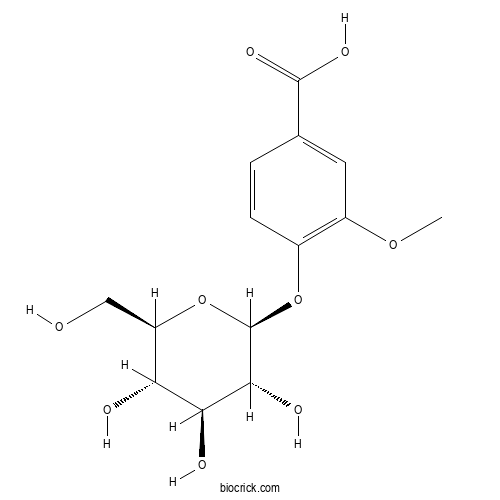Vanillic acid glucosideCAS# 32142-31-7 |

Quality Control & MSDS
3D structure
Package In Stock
Number of papers citing our products

| Cas No. | 32142-31-7 | SDF | Download SDF |
| PubChem ID | 14132337 | Appearance | White powder |
| Formula | C14H18O9 | M.Wt | 330.3 |
| Type of Compound | Phenols | Storage | Desiccate at -20°C |
| Synonyms | 4-Hydroxy 3-methoxybenzoic acid 4-β-D-glucoside | ||
| Solubility | Soluble in DMSO, methanol and water | ||
| Chemical Name | 3-methoxy-4-[(2S,3R,4S,5S,6R)-3,4,5-trihydroxy-6-(hydroxymethyl)oxan-2-yl]oxybenzoic acid | ||
| SMILES | COC1=C(C=CC(=C1)C(=O)O)OC2C(C(C(C(O2)CO)O)O)O | ||
| Standard InChIKey | JYFOSWJYZIVJPO-YGEZULPYSA-N | ||
| Standard InChI | InChI=1S/C14H18O9/c1-21-8-4-6(13(19)20)2-3-7(8)22-14-12(18)11(17)10(16)9(5-15)23-14/h2-4,9-12,14-18H,5H2,1H3,(H,19,20)/t9-,10-,11+,12-,14-/m1/s1 | ||
| General tips | For obtaining a higher solubility , please warm the tube at 37 ℃ and shake it in the ultrasonic bath for a while.Stock solution can be stored below -20℃ for several months. We recommend that you prepare and use the solution on the same day. However, if the test schedule requires, the stock solutions can be prepared in advance, and the stock solution must be sealed and stored below -20℃. In general, the stock solution can be kept for several months. Before use, we recommend that you leave the vial at room temperature for at least an hour before opening it. |
||
| About Packaging | 1. The packaging of the product may be reversed during transportation, cause the high purity compounds to adhere to the neck or cap of the vial.Take the vail out of its packaging and shake gently until the compounds fall to the bottom of the vial. 2. For liquid products, please centrifuge at 500xg to gather the liquid to the bottom of the vial. 3. Try to avoid loss or contamination during the experiment. |
||
| Shipping Condition | Packaging according to customer requirements(5mg, 10mg, 20mg and more). Ship via FedEx, DHL, UPS, EMS or other couriers with RT, or blue ice upon request. | ||
| Description | Reference standards. | |||||

Vanillic acid glucoside Dilution Calculator

Vanillic acid glucoside Molarity Calculator
| 1 mg | 5 mg | 10 mg | 20 mg | 25 mg | |
| 1 mM | 3.0276 mL | 15.1378 mL | 30.2755 mL | 60.551 mL | 75.6888 mL |
| 5 mM | 0.6055 mL | 3.0276 mL | 6.0551 mL | 12.1102 mL | 15.1378 mL |
| 10 mM | 0.3028 mL | 1.5138 mL | 3.0276 mL | 6.0551 mL | 7.5689 mL |
| 50 mM | 0.0606 mL | 0.3028 mL | 0.6055 mL | 1.211 mL | 1.5138 mL |
| 100 mM | 0.0303 mL | 0.1514 mL | 0.3028 mL | 0.6055 mL | 0.7569 mL |
| * Note: If you are in the process of experiment, it's necessary to make the dilution ratios of the samples. The dilution data above is only for reference. Normally, it's can get a better solubility within lower of Concentrations. | |||||

Calcutta University

University of Minnesota

University of Maryland School of Medicine

University of Illinois at Chicago

The Ohio State University

University of Zurich

Harvard University

Colorado State University

Auburn University

Yale University

Worcester Polytechnic Institute

Washington State University

Stanford University

University of Leipzig

Universidade da Beira Interior

The Institute of Cancer Research

Heidelberg University

University of Amsterdam

University of Auckland

TsingHua University

The University of Michigan

Miami University

DRURY University

Jilin University

Fudan University

Wuhan University

Sun Yat-sen University

Universite de Paris

Deemed University

Auckland University

The University of Tokyo

Korea University
- alpha-Peltatin
Catalog No.:BCN9858
CAS No.:568-53-6
- 5,6-Benzoflavone
Catalog No.:BCN9857
CAS No.:6051-87-2
- Quasipanaxatriol
Catalog No.:BCN9856
CAS No.:171903-78-9
- n-Tridecane
Catalog No.:BCN9855
CAS No.:629-50-5
- 3-Hydroxybenzoic acid
Catalog No.:BCN9854
CAS No.:99-06-9
- 2-Benzal-4-hydroxyacetophenone
Catalog No.:BCN9853
CAS No.:2657-25-2
- Colchiceine
Catalog No.:BCN9852
CAS No.:477-27-0
- Helveticoside
Catalog No.:BCN9851
CAS No.:630-64-8
- Flavonol
Catalog No.:BCN9850
CAS No.:577-85-5
- alpha-Ionone
Catalog No.:BCN9849
CAS No.:127-41-3
- Gardenin A
Catalog No.:BCN9848
CAS No.:21187-73-5
- Urushiol (15:3)
Catalog No.:BCN9847
CAS No.:83543-37-7
- Sphenanlignan
Catalog No.:BCN9860
CAS No.:866347-36-6
- Solanidine
Catalog No.:BCN9861
CAS No.:80-78-4
- Somnifericin
Catalog No.:BCN9862
CAS No.:173693-57-7
- 3,29-O-Dibenzoyloxykarounidiol
Catalog No.:BCN9863
CAS No.:389122-01-4
- ICG-001
Catalog No.:BCN9864
CAS No.:780757-88-2
- 4-(4-Methoxyphenyl)-2-butanone
Catalog No.:BCN9865
CAS No.:104-20-1
- Tropic acid
Catalog No.:BCN9866
CAS No.:529-64-6
- 1,2-Dimethoxybenzene
Catalog No.:BCN9867
CAS No.:91-16-7
- 15-Methoxy-16-oxo-15,16H-strictic acid
Catalog No.:BCN9868
CAS No.:1356388-38-9
- Datiscin
Catalog No.:BCN9869
CAS No.:16310-92-2
- Cannabiscitrin
Catalog No.:BCN9870
CAS No.:520-14-9
- Lappaconine
Catalog No.:BCN9871
CAS No.:23943-93-3
Identification of Somatosensory Compounds Contributing to Slipperiness and Thickness Perceptions in Canned Prunes (Prunus domestica).[Pubmed:32202115]
J Agric Food Chem. 2020 Nov 18;68(46):13160-13167.
The role of small molecules on the somatosensory properties of prunes (Prunus domestica) was investigated. Sensory descriptive analysis defined two main somatosensations, "thickness" and "slippery". On the basis of these two attributes, sensory-guided multidimensional fractionation techniques allowed for the isolation of four main compounds, which were identified by mass spectrometry and comparison to authentic standards. Three compounds were identified as monosubstituted isomers of chlorogenic acid, namely, 1-O-caffeoylquinic acid (1-CQA), 3-O-caffeoylquinic acid (3-CQA), and 4-O-caffeoylquinic acid (4-CQA), in addition to a fourth, Vanillic acid glucoside (VG). Sensory recombination model analysis of each compound at endogenous concentrations of the prunes indicated that all compounds significantly contributed to slippery sensations, whereas 3-CQA, 4-CQA, and VG contributed to thickness sensations (alpha = 0.05).


